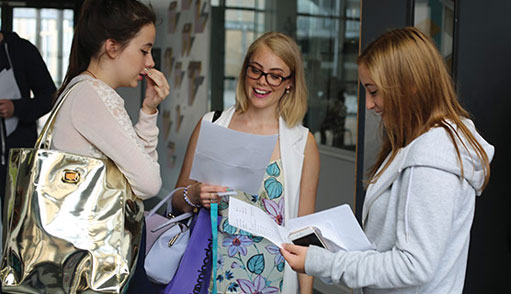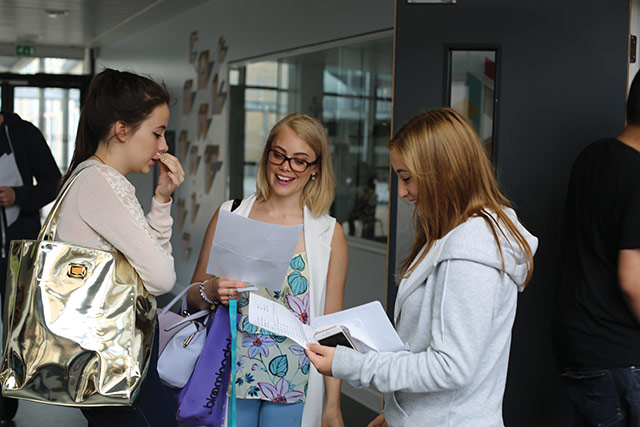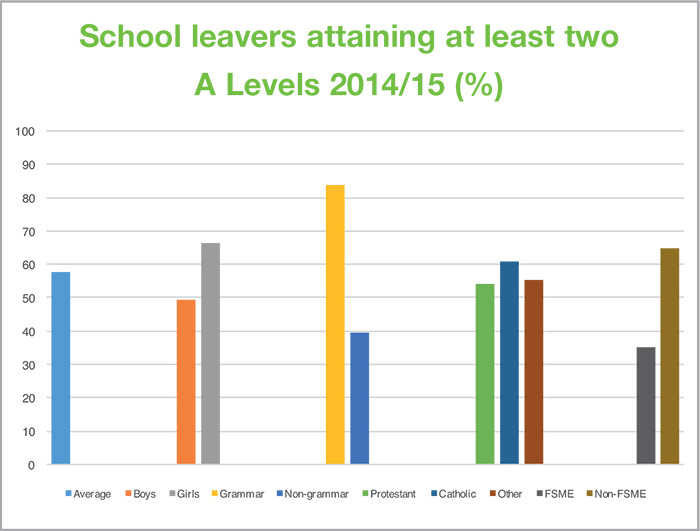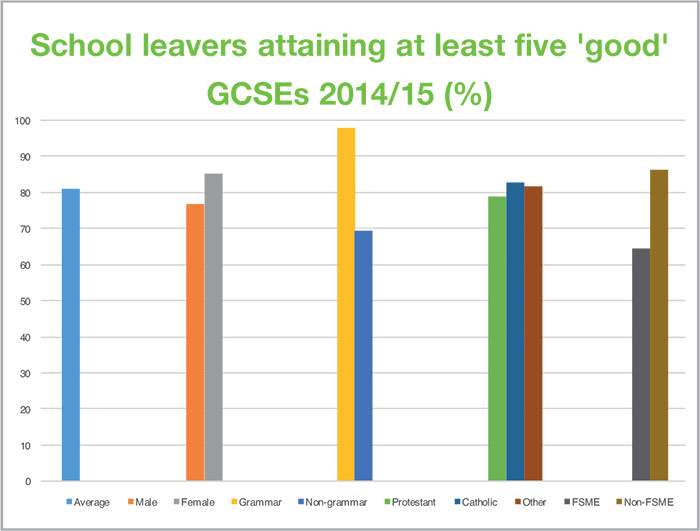School leaver qualifications


agendaNi analyses the most recent tranche of annual statistics for qualifications and destinations of Northern Ireland post-primary leavers provided by the Department of Education.
In five years, between 2009/10 and 2014/15 there was a 9.2 per cent surge in the volume of school leavers attaining at least five GCSEs at A* to C grades from 71.9 per cent to 81.1 per cent. The vast bulk of the improvement during this period occurred in non-grammar schools, where the number of students achieving five ‘good’ GCSEs increased by 14.4 per cent to 69.3 per cent. Meanwhile, their contemporaries in grammar schools produced a 1 per cent increase, with 98 per cent of pupils securing at least five GCSEs.
Catholic students slightly exceeded their Protestant peers by 3.8 per cent with 82.7 per cent achieving at least five GCSEs compared to 78.9 per cent.
Including English and maths
At the same time, a lower proportion of students possess at least five ‘good’ GCSEs including both English and maths. The figure has, however, increased by 6.9 per cent to 66 per cent since 2009/10. Just over two fifths of students with free school meal entitlement (FSME), or 41.3 per cent, achieved this, up 6.4 per cent since 2014/15.
While almost two thirds of both girls and boys achieved at least five GCSEs A* to C, including English and maths, there was an 8.9 per cent variance between the two, with 70.5 per cent and 61.6 per cent respectively.
No qualifications
In 2014/15 122 students left school without any GCSEs representing a total of 0.5 per cent of school leavers. Of these, 93 left school without any formal qualifications, a proportion of 0.4 per cent of the leavers cohort that year. More boys (0.6 per cent) left school without any GCSEs than girls (0.5 per cent). Similarly, more non-grammar school leavers (0.9 per cent) emerged no GCSEs that their grammar counterparts (0.1 per cent).
When reflecting upon free school meal entitlement, a similar number of FSME pupils (66) left school without any GCSEs when compared with non-FSME students (56). However, in the case of non-FSME, this was a much smaller proportion of the cohort (0.3 per cent) relative to the 1.2 per cent of the FSME cohort.
A levels
The proportion of school leavers leaving with two or more A levels at A* to E grade increased by 5 per cent to 57.7 per cent between 2009/10 and 2014/15. Likewise, the proportion of those leaving with three or more also increased by 2.7 per cent up to 38.2 per cent. In correlation with previous trends, girls continue to outperform boys. Of female school leavers, 66.2 per cent attained two or more A levels while 45.7 per cent achieved three or more. The corresponding figures for males are 31.1 per cent and 49.5 per cent.
The proportion of grammar school students leaving school with two or more A levels decreased from 85.3 per cent to 83.6 between 2009/10 and 2014/15. However, the disparity with non-grammars is significant. While representing a 9 per cent increase on 2009,10, only 39.6 per cent of non-grammar school leavers achieved at least two A levels. At the same time, a greater number of Catholic pupils (61 per cent) achieved two or more A levels when compared with their Protestant contemporaries (54 per cent).
Almost two thirds (64.7 per cent) of non-FSME school leavers achieved at least two A levels in contrast with the FSME cohort, of which just over a third (35.3 per cent) managed the same.
Destinations
A consistent outperformance of male school leavers by females at both GCSE and A level is reflected in the figures for those who entered a Higher Education Institution (HEI). While a total 42.3 per cent of school leavers in 2014/15 enrolled in a HEI, a significantly greater number of girls (50.2 per cent) continued when compared with boys (34.7 per cent). A proportion of 6.4 per cent more Catholic students (45.4 per cent) entered higher education when compared Protestant school leavers (39 per cent). Catholics (73.8 per cent) were also notably more likely to enter a HEI in Northern Ireland than Protestants (60.5 per cent).
Likewise, males were 2.3 per more likely to enrol in a Northern Ireland HEI than females.
At the same time, those opting to continue into Further Education colleges increased by 1.9 per cent between 2009/10 and 2014/15. Over a third of school leavers (35 per cent) followed this route. While 81.1 per cent of non-FSME students entered either HE or FE institutions, this proportion reduced to 65.3 per cent when considering leavers who were entitled to free school meals. Furthermore, boys (13.5 per cent) were comparatively more likely to enter training than girls (5.9 per cent).
In total, 95.5 per cent of the 2014/15 school leaver cohort were mapped as having entered either education, employment or training. Grammar school leavers (97.6 per cent) were proportionally more likely to access one of these destinations than their non-grammar counterparts (94 per cent).







